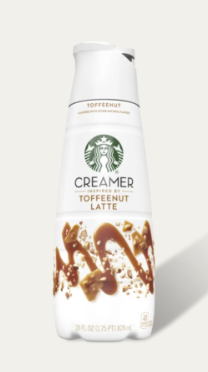The Environmental Impact of Your Favorite Creamers - Starbucks, Coffee Mate, and International Delight
You start your day with a cup of coffee, often relying on creamers to add flavor and texture. As you choose between Starbucks, Coffee Mate, and International Delight, have you considered the environmental impact of your selection? Your daily creamer habit can have a significant effect on the planet, from packaging waste to resource consumption. By examining the eco-footprint of these popular brands, you can make informed decisions about your coffee routine and its consequences.
Key Takeaways:
- The environmental footprint of popular creamers like Starbucks, Coffee Mate, and International Delight is significant due to their packaging waste and resource consumption.
- Sustainable alternatives such as plant-based creamers and refillable containers can help reduce the carbon emissions and waste generation associated with traditional creamers.
- Consumers can make a positive impact by choosing eco-friendly creamers, reducing coffee waste, and supporting companies that prioritize environmental responsibility and sustainable practices.
Environmental Impact of Coffee Creamers
For many of you, coffee creamers are a daily staple, but have you considered the environmental impact of your favorite brands, such as Starbucks, Coffee Mate, and International Delight? As you sip your coffee, you're not only affecting your taste buds, but also the planet.
Overview of the Problem
Beneath the surface of your daily coffee routine lies a complex issue: the environmental impact of coffee creamers. You may not think twice about tossing that creamer container, but it contributes to a larger problem that affects your community and the environment.
Statistics on Creamer Waste
Comparable to the amount of coffee you drink, the waste generated by creamer containers is staggering. You might be surprised to learn that millions of creamer containers end up in landfills each year, contributing to pollution and waste management issues.
But as you investigate deeper into the statistics, you'll find that the problem is more complex than you thought. The production, packaging, and disposal of creamer containers all have a significant impact on the environment, from the energy used to manufacture them to the waste they generate, affecting your carbon footprint and the health of your planet.
Starbucks Creamers
Some of your favorite Starbucks creamers may be harming the environment, and it's vital to consider the impact of your daily coffee routine. You can make a difference by choosing eco-friendly options and being aware of the ingredients and packaging used by Starbucks.
Ingredients and Packaging
Ingredients like sugar, cream, and flavorings are used in Starbucks creamers, which can have a significant environmental impact. You should check the labels to understand what you're putting into your body and the planet, and consider the packaging, which is often made of non-recyclable materials.
Sustainability Efforts
Across the globe, companies like Starbucks are taking steps to reduce their environmental footprint, and you can be part of this movement by supporting sustainable practices. You can look for creamers with eco-friendly packaging and ingredients, and encourage Starbucks to continue their efforts in reducing waste and promoting sustainability.
Hence, as you consider the sustainability efforts of Starbucks, you'll find that the company has set goals to reduce greenhouse gas emissions and waste. You can contribute to these efforts by choosing Starbucks creamers with sustainable packaging and ingredients, and by supporting the company's initiatives to reduce their environmental impact, you'll be making a positive difference in the planet's well-being.
Coffee Mate Creamers
All Coffee Mate creamers have a significant impact on the environment, from production to disposal. You may be surprised to learn about the effects of your daily creamer on the planet.
Environmental Footprint
About the environmental footprint of Coffee Mate creamers, you should know that they contribute to greenhouse gas emissions and waste generation. Your choice of creamer can make a difference in reducing your carbon footprint.
Comparison to Other Brands
For comparison, consider the following table:
| Brand | Environmental Impact |
|---|---|
| Coffee Mate | High greenhouse gas emissions |
| Starbucks | Moderate waste generation |
Environmental Comparison. You can see how Coffee Mate compares to other brands in terms of environmental impact.
Due to the varying environmental impacts of different creamer brands, you can make informed decisions about your creamer choices. Consider the following table:
| Brand | Sustainability Efforts |
|---|---|
| Coffee Mate | Limited recycling programs |
| International Delight | Renewable energy sources |
Sustainability Efforts. You can choose a brand that aligns with your values and reduces your environmental footprint.
International Delight Creamers
Not all creamers are created equal, and International Delight is a popular choice among coffee lovers. You may be wondering about the environmental impact of your favorite International Delight creamers.
Eco-Friendly Initiatives
EcoConsciously, International Delight has taken steps to reduce its environmental footprint, such as using recyclable materials in its packaging and reducing waste in its manufacturing process, which affects your daily choices.
Consumer Impact
Impactfully, your choice of creamer can have a significant effect on the environment, and International Delight is no exception, as you consider the consequences of your daily coffee habit.
For instance, when you choose International Delight creamers, you are supporting a company that has made efforts to reduce its carbon footprint, and you can feel better about your daily coffee routine, knowing that your choices are making a difference in reducing waste and promoting sustainability.
Comparison of the Three Brands
Unlike other creamers, these three brands have distinct environmental impacts. You can find discussions about their effects on Thoughts on this coffee creamer? : r/Celiac. The comparison is broken down into:
| Brand | Environmental Impact |
|---|
Environmental Rankings
Comparatively, you'll find that each brand has its own set of environmental concerns, from packaging to sourcing, which affect your choice.
Recommendations for Consumers
Across the board, you have the power to make a difference by choosing eco-friendly options and reducing waste in your daily coffee routine.
But as you consider your creamer options, you should also think about the broader implications of your purchase, from the ingredients used to the company's overall sustainability practices, and how you can make informed decisions that align with your values and promote a more environmentally conscious lifestyle.
Alternatives to Traditional Creamers
Once again, you have the power to make a change by exploring alternatives to traditional creamers, which can significantly reduce your environmental footprint and promote sustainability in your daily coffee routine.
Plant-Based Options
Typically, you can find plant-based creamers made from oats, almonds, or coconut milk, offering a more eco-friendly option compared to traditional dairy-based creamers, and allowing you to make a positive impact on the environment with your daily choices.
DIY Creamer Recipes
With a few simple ingredients, you can create your own creamers at home, reducing packaging waste and allowing you to control the ingredients used, making your coffee habit more sustainable and tailored to your taste preferences.
In addition, making your own creamer recipes enables you to experiment with various flavors and ingredients, such as vanilla, cinnamon, or nutmeg, while also avoiding unwanted additives and preservatives found in commercial creamers, giving you a healthier and more environmentally friendly coffee experience.
To wrap up
With this in mind, you now have a better understanding of the environmental impact of your favorite creamers, including Starbucks, Coffee Mate, and International Delight. You can make informed decisions about your daily coffee routine, considering the effects of your choices on the planet. Your awareness of the eco-friendly options available will help you reduce your carbon footprint and promote sustainability in your daily life.
FAQ
Q: What is the environmental impact of using non-dairy creamers from popular brands like Starbucks, Coffee Mate, and International Delight?
A: The environmental impact of using non-dairy creamers from these brands can be significant. Many non-dairy creamers are made from highly processed ingredients, such as palm oil, almonds, and coconut oil, which can contribute to deforestation, water pollution, and greenhouse gas emissions. Additionally, the packaging of these creamers, often made from single-use plastics, can contribute to the already overwhelming plastic waste problem. Starbucks, Coffee Mate, and International Delight have made efforts to reduce their environmental footprint, but there is still more work to be done to minimize the impact of their products on the environment.
Q: How do the environmental impacts of Starbucks, Coffee Mate, and International Delight creamers compare to one another?
A: The environmental impacts of these brands' creamers vary. Starbucks has made a commitment to power 50% of its company-owned stores with renewable energy and has set a goal to make all of its cups and lids recyclable by 2025. Coffee Mate, on the other hand, has focused on reducing waste in its manufacturing process and has implemented a recycling program for its packaging. International Delight has also made efforts to reduce its environmental impact, including using sustainable sourcing practices for its ingredients. However, a detailed comparison of the three brands' environmental impacts is complex and depends on various factors, such as the specific ingredients and packaging used in each product.
Q: What can consumers do to reduce the environmental impact of their creamer usage, and are there more sustainable alternatives to Starbucks, Coffee Mate, and International Delight creamers?
A: Consumers can take several steps to reduce the environmental impact of their creamer usage, such as choosing creamers with minimal packaging, opting for refillable containers, and selecting products made from sustainable ingredients. There are also several more sustainable alternatives to Starbucks, Coffee Mate, and International Delight creamers available, including creamers made from oat milk, hemp milk, and other plant-based ingredients. Additionally, consumers can consider making their own creamers at home using simple ingredients like coconut oil, almond milk, and vanilla extract. By making these choices, consumers can help reduce the environmental impact of their daily coffee routine and promote more sustainable practices in the creamer industry.





